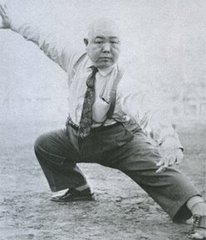 |
| Browsing in Singapore's Tong Lian store |
 |
| Ma Hong |
Can we say that Taijiquan is in such good hands today? How many teachers stress the realities of real Taijiquan and how many students are prepared to go down the traditional route. Traditional Taijiquan has many sayings that point to this complexity:
"Three years small success, five years medium success, ten years great success"
"One days practice, one days skill"
"Treat 10 years as if it were one day" etc etc...
I was in Tiantan park in 1998 killing a few days before we travelled to Henan. We walked through the park in the early morning looking at the different Taijiquan and Qigong players. What I was looking for really was any interesting Chen Taijiquan, but what arrested my attention was an old Wu style practitioner. At that time there were lots of groups, some being quite large. Zhang Baosheng was training with one student. As we watched it was immediately obvious that this was high quality Taijiquan. When he finished his routine he came over to chat and we arranged to do some training with him over the next few days.
 |
| Beijing 1998 with Zhang Baosheng and student |
Close to Zhang's patch in the park a large group trained in one of the modern simplified forms of Taijiquan. With accompanying music and many of the students chatting casually to each other as the leader set the pace, it was little more than a nice social way to begin the day. His one student, on the other hand was serious and disciplined. When we commented on this Zhang said that unfortunately that was the way it was now - "young people in China are not interested in the old ways". While he felt an obligation to pass on what he himself had been taught, he sadly concluded that the authentic Taijiquan was in real danger of becoming extinct. When we we visited him again in 2005 or 2006 he was in the same place - still training and still looking great. Now in his eighties, and now alone - Zhang's sole student had left to find work.
Contrast the above approach with Jet Li's new Taiji Zen project, a high-profile modern example of Taijiquan in the "internet age". Prospective learners are wooed with the possibility of achieving a 9th Duan grade in as little as 3 years. And to validate their "achievement" at each level they receive a certificate signed by Jet Li himself! Forget the fact that Jet Li is a wushu guy who did a little Taiji on the side, the difference in approach could hardly be more striking. But sadly it seems that this is what people want today. I've touched on this phenomena in previous blogs with the explosion of short and simplified Taijiquan forms and fast track instructor courses. If that's what people want that's what they want, but don't anyone kid themselves that they will get any of the often mentioned benefits of Taijiquan. The traditional art is a lifetime process of constant introspective refinement. Traditional skills are hard earned. An individual is said to have "good gongfu", whether it be in Taijiquan or any other pursuit, when it is clear to a skilled observer that they have put three elements into their discipline: The first is that they have studied for an extended period of time; the second is that they have worked very hard or "eaten bitter"; and the third is that they have exhibited yongxin - literally "using their heart" - more than just working hard, they have given it their full, deep and unwavering concentration.
 |
| Wang Shujin - Don't neglect the fundamentals! |
I'll leave the last word on whether this fast track type of Taijiquan can give results anything like the old ways to Wang Shujin. Talking about the merits of slowly and meticulously training the fundamentals of Taijiquan (in this case the likelihood of gaining high skills without seriously training standing): "You must practice Post Standing (Zhan Zhuang). No matter which Chinese martial art you study, Post Standing is considered fundamental practice. In ancient times, students had to practice standing for one or two years before they were allowed to learn any forms. That is why each generation produced outstanding martial artists. Society and people's way of thinking have changed, making adapting to these requirements difficult...If you skip the fundamentals, your form will remain undeveloped and you will be ridiculed by experts".



